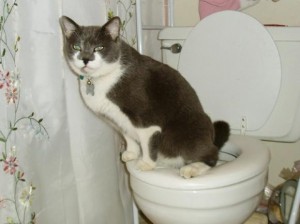Why Flushing Cat Poop Down Your Toilet Is Bad - Tips for Proper Disposal
Why Flushing Cat Poop Down Your Toilet Is Bad - Tips for Proper Disposal
Blog Article
This article listed below about Can You Flush Cat Poop Down The Toilet? is fairly intriguing. Check it out for your own benefit and decide what you think about it.

Intro
As feline owners, it's vital to be mindful of just how we throw away our feline buddies' waste. While it might appear practical to flush feline poop down the toilet, this method can have detrimental repercussions for both the environment and human health and wellness.
Ecological Impact
Flushing pet cat poop presents hazardous virus and parasites right into the water supply, posturing a considerable threat to water ecosystems. These pollutants can negatively impact aquatic life and compromise water top quality.
Health and wellness Risks
Along with environmental worries, flushing feline waste can additionally position health and wellness threats to people. Pet cat feces may consist of Toxoplasma gondii, a bloodsucker that can cause toxoplasmosis-- a potentially serious ailment, particularly for expecting ladies and people with weakened immune systems.
Alternatives to Flushing
Luckily, there are more secure and a lot more responsible methods to dispose of cat poop. Think about the following options:
1. Scoop and Dispose in Trash
One of the most common technique of dealing with feline poop is to scoop it right into a naturally degradable bag and toss it in the trash. Be sure to utilize a committed litter scoop and get rid of the waste quickly.
2. Use Biodegradable Litter
Select eco-friendly pet cat clutter made from materials such as corn or wheat. These litters are environmentally friendly and can be safely thrown away in the garbage.
3. Hide in the Yard
If you have a backyard, consider burying cat waste in a designated location far from veggie yards and water resources. Make sure to dig deep sufficient to avoid contamination of groundwater.
4. Set Up a Pet Waste Disposal System
Purchase a family pet waste disposal system particularly developed for cat waste. These systems use enzymes to break down the waste, decreasing odor and environmental impact.
Conclusion
Responsible pet possession expands past supplying food and shelter-- it also involves correct waste monitoring. By refraining from flushing cat poop down the commode and opting for different disposal methods, we can decrease our ecological footprint and protect human wellness.
Why Can’t I Flush Cat Poop?
It Spreads a Parasite
Cats are frequently infected with a parasite called toxoplasma gondii. The parasite causes an infection called toxoplasmosis. It is usually harmless to cats. The parasite only uses cat poop as a host for its eggs. Otherwise, the cat’s immune system usually keeps the infection at low enough levels to maintain its own health. But it does not stop the develop of eggs. These eggs are tiny and surprisingly tough. They may survive for a year before they begin to grow. But that’s the problem.
Our wastewater system is not designed to deal with toxoplasmosis eggs. Instead, most eggs will flush from your toilet into sewers and wastewater management plants. After the sewage is treated for many other harmful things in it, it is typically released into local rivers, lakes, or oceans. Here, the toxoplasmosis eggs can find new hosts, including starfish, crabs, otters, and many other wildlife. For many, this is a significant risk to their health. Toxoplasmosis can also end up infecting water sources that are important for agriculture, which means our deer, pigs, and sheep can get infected too.
Is There Risk to Humans?
There can be a risk to human life from flushing cat poop down the toilet. If you do so, the parasites from your cat’s poop can end up in shellfish, game animals, or livestock. If this meat is then served raw or undercooked, the people who eat it can get sick.
In fact, according to the CDC, 40 million people in the United States are infected with toxoplasma gondii. They get it from exposure to infected seafood, or from some kind of cat poop contamination, like drinking from a stream that is contaminated or touching anything that has come into contact with cat poop. That includes just cleaning a cat litter box.
Most people who get infected with these parasites will not develop any symptoms. However, for pregnant women or for those with compromised immune systems, the parasite can cause severe health problems.
How to Handle Cat Poop
The best way to handle cat poop is actually to clean the box more often. The eggs that the parasite sheds will not become active until one to five days after the cat poops. That means that if you clean daily, you’re much less likely to come into direct contact with infectious eggs.
That said, always dispose of cat poop in the garbage and not down the toilet. Wash your hands before and after you clean the litter box, and bring the bag of poop right outside to your garbage bins.
https://trenchlesssolutionsusa.com/why-cant-i-flush-cat-poop/

As a passionate reader about Don’t flush cat feces down the toilet, I thought sharing that piece of content was a good idea. Liked our article? Please share it. Let someone else check it out. Thanks a lot for your time. Visit us again soon.
Get Started Report this page